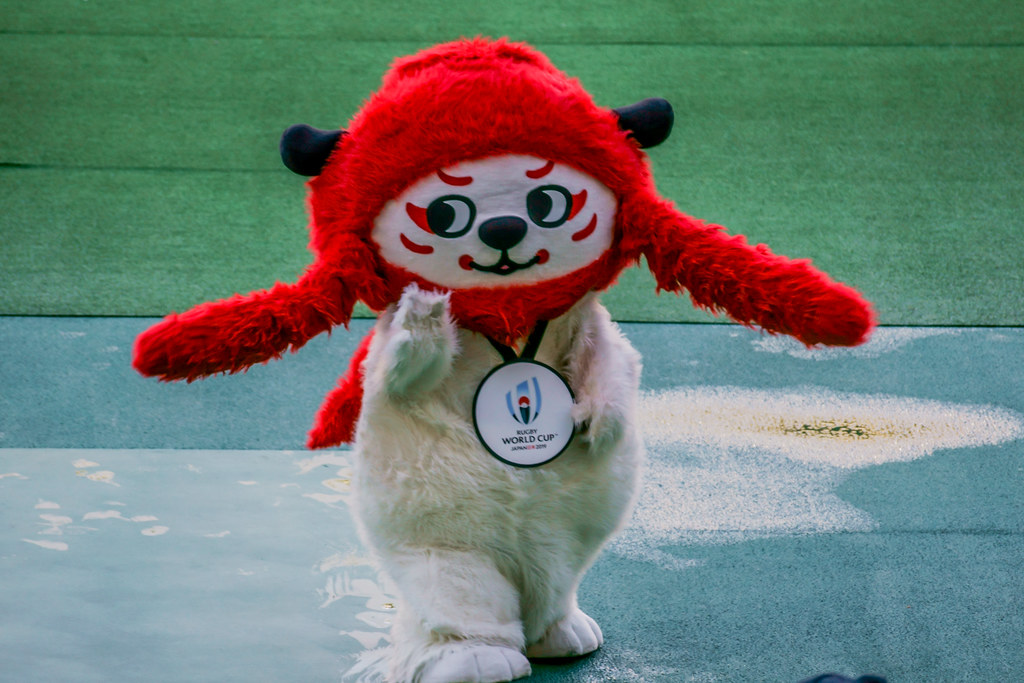
Japan’s Wild World of Mascots Adds Rugby World Cup’s Ren-G To Its Ranks
The mythical lion-like creatures have joined the likes of Kumamon and Chiitan
Sep 18, 2019
Photography by Joshua Mellin
![]()
Mascots are a part of everyday life in Japan. They weave into the societal fabric seamlessly. Known as yuru-chara, they represent sports teams, cities, neighborhoods, trains, companies, food items, there’s a seemingly endless parade of cartoon characters rooting on anything that can be imagined. At times it’s as if the animated world from Who Framed Roger Rabbit sprang to life.
They might be a silly inconvenience if you run into one crossing the street, or get stuck behind one on the escalator, but you wouldn’t fault a mascot with an oversized head for blocking the path of a doorway. It’s just who they are, they can’t help their heads are so large. Plus, they’re a big part of the economy. Character-driven sales by these mascots reaches into the billions annually.
While Japan’s love of mascots may stem from iconic characters like Hello Kitty, today’s popular main-stays are decidedly more bizarre. Many are officially licensed, some simply made up, while others self-appointed. Perhaps the most famous unofficial mascot is Chiitan, a self-described “0-year-old fair baby” otter with no gender that wears a turtle as a hat, who also recently engaged in a mostly one-way social media feud with John Oliver, the host of HBO’s Last Week Tonight.
The strange mash-up is a common staple of newer mascot’s identities. Like Wakkuma, the mascot of Toyo Tires, simply half bear/half tire. Often mascots bodies will be pieced together from elements of their home regions. Take Birakki for example: a tomato with cow horns, a pig snout, and a lily-of-the-valley tail, representing the locale of Biratori Town.
Many of these mutant-like mascots are recorded on twitter by @mondo_mascots, an account run by British-born, Tokyo-based Chris Carlier that offers an ongoing, deep dive into the ever-growing sub culture, seeking hem out in real time to share with his followers.
Mascots also like to do things in groups. The largest mascot dance was 134 who joined at Huis Ten Bosch theme park in 2013, and 376 got together for the 2013 Yuru-chara summit in Hanyu in the same year.
Often times a mascot will outgrow their original design. That’s what happened to Kumamon, the cute bear created to draw tourists to the Kumamoto Prefecture after the Kyushu Shinkansen train opened. He ended up becoming a national star, and a year later was voted top spot in the annual mascot competition known as the Yuru Chara Grand Prix 2018. Now he’s one of the most recognizable cartoon characters worldwide.
Sports mascots of course thrive in this environment. The Yomiuri Giants, sometimes known as the New York Yankees of Tokyo, even have an entire family of orange rabbits known as the Giabbits, each with extensive back stories. There’s two twin adult Giabbits named Mr. Giabbit (who wears #555) and Giabyi (who wears #333), an adult female named Vicky, and twin children: a boy named Tsuppy and girl named Chappy. There’s even added a Grandpa Giabbit.
Two of the most popular mascots on the streets of Japan in 2019 are Ren-G, representatives of the Rugby World Cup. After Japan’s miraculous 2015 win over powerhouse New Zealand in that year’s event there’s been a lot of excitement around the sport and it extends to their furry mascots, sacred lion-like mythical creatures that are said to bring happiness and ward of evil.
Like many mascots, Ren-G has several layers of meaning. Hailing from unknown origins, they embody the five spirits of rugby, with their missive to “spread the spirit of rugby from Japan to Asia and to the rest of the world.” On their journey they’ve made friends with a lot of Japan’s mascot population.
What really has captured imaginations though is the Ren-G dance, a trick in which the dual Ren-G swing their hair in a wild circle. As international ambassadors, it’s easy to see them remain a presence for years to come, much like Tokyo’s 2020 Olympic mascots Miraitowa and Someity.
Miraitowa is a combination of the Japanese words for future and eternity while Someity comes from a popular cherry blossom variety “Someiyoshino” and echoes the English phrase “so mighty.” Their design was selected by elementary schoolchildren across Japan, connecting them to an entire generation.
“These mascots are you friends,” Yoshiro Mori, Tokyo 2020 President, stated at their unveiling ceremony. Noting the designs and names were picked together he proclaimed “This Olympics belongs to everyone.”
Much the same, the mascots belong to everyone. They are a product expressly made to bring joy to the masses, and in that way embody the type of playfulness that makes visiting Japan a wonderment.
Current Issue

Issue #72
Apr 19, 2024 Issue #72 - The ‘90s Issue with The Cardigans and Thurston Moore
Most Recent
- 12 Best Songs of the Week: Charly Bliss, Jessica Pratt, The WAEVE, Hamish Hawk, and More (News) —
- John Carpenter on ‘Lost Themes IV: Noir’ (Interview) —
- Thomas Powers (of The Naked & Famous) Shares New Single, “Empty Voices” feat. Julien Baker (News) —
- illuminati hotties Shares Video for New Song “Can’t Be Still” and Announces New Tour Dates (News) —
- Jordan Lindley Shares New Single “Sometime Someday” (News) —

Comments
Submit your comment
January 28th 2020
11:40pm
I read your Blog I am sure your infroamtion is useful for me because I am a travel freak and it is my passion. In my life I have visited many attractions. These days I and my friends will visit <a >west coast bus</a> I am sure this is a wonderful trip for me.
February 21st 2020
11:12pm
I will visit this after <a >tours west coast</a>.
March 7th 2020
12:05am
I always like this kind of article which I have shared here, I will try to read about this more after my <a >bus tours of chicago</a>.